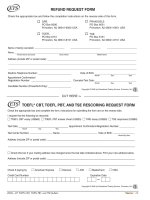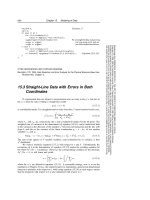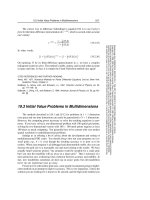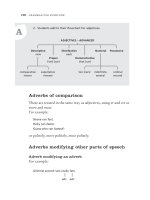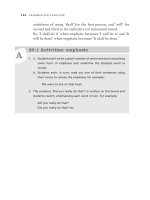Tài liệu Grammar for everyone part 4 ppt
Bạn đang xem bản rút gọn của tài liệu. Xem và tải ngay bản đầy đủ của tài liệu tại đây (142.96 KB, 7 trang )
Most modern languages have systems that indicate number
(singular or plural) and tense (when something takes place, i.e. in
the present, past or future). Another important distinction denotes
the purpose of a statement, i.e. is it just a simple statement, asking
a question or giving a command.
Intonation
It is important, too, to be aware of some of the principles, or at
least guidelines for the way we use our voices and thereby convey
the purpose of our utterance. It is easy to overlook the fact that
we cannot use intonation in written communication – neither
can we be asked to repeat or clarify it; our writing must convey
all our intentions. Test the following passage by reading it in
monotone.
‘Hello Dad. Oh no! Mick’s just fallen in the fishpond. Get out.’
‘Help, help.’
‘He can’t. Get a rope. Quick!’
‘Catch the rope. Good. How did you manage to fall in? Now I’m
all wet.’
The same passage written without punctuation would be impos-
sible to interpret accurately.
Ambiguity
As teachers, we need to be highly conscious of the potential for
ambiguity that exists in a language like English, which depends
heavily on word order for meaning. A typical kind of ambiguous
sentence is that in which a clause is misplaced, for example: ‘Sisters
were united after 30 years in the check-out queue.’ Instructions
and examples need to be carefully monitored to avoid confusion,
and students need to be made aware of this problem in their own
writing and speaking.
11
t eA c hi nG st r Ate G ie s f o r the c o nt e Mp orA rY cl Ass ro o M
Long-term memory
We always aim for our students to retain our teaching in the
long-term memory. The human brain actually encompasses
infinite memory but the secret of retrieval lies in how we record
information in the first place.
We can use the analogy of a computer, which is itself designed
to imitate the operation of the human brain. We know that we have
to install a computer program in a totally accurate way; omitting
even one dot may impede its function. Then once the program has
been successfully installed, we are able to add information to its
files and recall it at the click of a mouse.
As the human brain can store infinitely more information
than any computer, we can see the importance of accurately filing
the information that we want it to retain. By ensuring that our
teaching follows a logical progression, we are enabling each detail
to be filed systematically; only in that way do we establish a fully
functioning system for recall.
The best time to learn
Looking at English books for seniors it seems amazing that
students at this level are having phrases and clauses explained to
them long after they should be manipulating them confidently
and showing a high degree of language competence. No wonder
they are bored and frustrated at what, to them, must seem belated
and therefore irrelevant.
Ideally, this information should form a substantial part of
the English curriculum in upper primary so that correct forms
of sentence structure have been well practised by the time that
the mature student needs to concentrate more on subject matter.
Upper primary years can be perceived as the preparation time
during which skills are honed, furnishing students with the abil-
ity to read and write competently in a variety of subject areas.
Moreover, the junior student is far more receptive to training in the
12
G rA M MA r f or eV e rY on e
basic mechanics of language, and while the teacher has an ongoing
responsibility to coach and direct, the more mature mind should
now be exploring more creative ways of manipulating language
for a variety of purposes.
Structure the program
Because grammar is such a structured science, it is of the greatest
importance that we teach it in a structured way. As it pertains to
everyday speech and writing, to the visible and concrete as well
as the abstract objects in life, it is not difficult to start grammar
instruction in the third year of schooling. Once children have
mastered the requirements of a sentence – that it ‘starts with a
capital letter and ends with a full stop’ – they have already been
trained in two rudimentary principles of grammar.
Now we need to establish the foundation on which our structure
is to be built, namely the parts of speech, and the terminology,
definition and function of each one. The order in which we teach
these also forms a logical sequence. Using the logical progression
of simple to complex allows us to teach in easy steps whereby one
concept fits on to the previous one to form a cohesive whole, just
as by building brick by brick, we can construct a solid and stable
wall.
As this book is designed for all teachers, including some who
have learnt little or no grammar themselves, it is important that
all detail is included. If you choose to skip, bear in mind that tips,
activity suggestions and tutors’ discoveries are all included.
13
t eA c hi nG st r Ate G ie s f o r the c o nt e Mp orA rY cl Ass ro o M
Practical suggestions
First, provide all students with an exercise book in which to build
up their own reference text.
Teaching and understanding concepts
Sometimes students will have a good idea about a concept long
before they can put a name to it; for example, most will be well
aware of tense long before they know the term or realise that there
is one, simply because they are expressing it naturally in every
statement they make. We teach these things so that they can talk
about them, understand how to use them correctly and well, and
know how to apply them to other languages.
…
14
Concepts are taught, ideally, when they arise naturally in
context and teachers may take quick opportunities to divert
attention to certain aspects that arise. This is not always possible
in a demanding curriculum, and either way, some terms may be
explained in a simple manner and discussed and practised more
fully when they arise in the curriculum. For example, a child learns
early that a sentence can consist of a noun and a verb. The verb
must have a subject for it to make sense. The term ‘predicate’ can
be explained later. It is true that children do like ‘long’ words but
they should understand them and not be bogged down with them
in a meaningless way.
Homework
Homework should always be brief in the early stages – never
onerous. To be effective it should be based on the learning of the
same day, providing revision and consolidation, bearing in mind
that much of what we learn will be forgotten if not reinforced
within 12 hours.
Introducing lessons
It is a good idea to vary the way in which you introduce a subject,
especially if you are teaching reluctant students. Some students
may be turned off by the mention of grammar, so be creative.
Rather than beginning your lesson with something like ‘Today
we are going to do verbs’, you might plunge straight into an
activity, the purpose of which is explained later. For example, you
might ask the students to say what they did last evening or this
morning before school. At the end of the discussion a list of the
‘doing’ words (verbs) mentioned could be made.
A discussion could evolve from asking students what they
had for tea the day before. After all have had a turn, some of the
answers could be written on the board.
15
p rA c ti cAl s u GG e st ion s
Dan had curry and rice
Julie had shepherds pie etc.
Each answer forms the object of the sentence. To ensure that
the lesson is remembered, the students might each write a sentence
telling of something they would not like to have – the sentences to
be read out. For example:
I would not like snake’s eggs.
I would not like squashed toad.
Mediums and learning aids
Use a variety of mediums. Students enjoy writing on the board,
writing on concrete with chalk, and making charts. Charts drawn
on large sheets of project card can be laminated, then written on
with erasable whiteboard markers.
16
G rA M MA r f or eV e rY on e
Kinetic activities
Miming, acting skits and charades are all useful activities for
reinforcing grammar concepts. They can be composed and
performed in groups or acted spontaneously. These are important
for kinetic learners and create memorable lessons.
Learning games
Much practice can be given by using containers from which
students pick cards or pieces of paper. These could be printed with
words or questions to be used and scored in numerous ways.
Wall charts/posters
These are always helpful and most effective when students make
them themselves or help to make them. For example:
a. Singular Object Plural Object
subject subject
I me we us
you you you you
he/she/it him/her/it they them
b. Adjective Noun
wise wisdom
wide width
hot heat
c.
Few (a number you can count) Less (some you can’t count)
eggs rice
people sand
slices rain
17
p rA c ti cAl s u GG e st ion s


